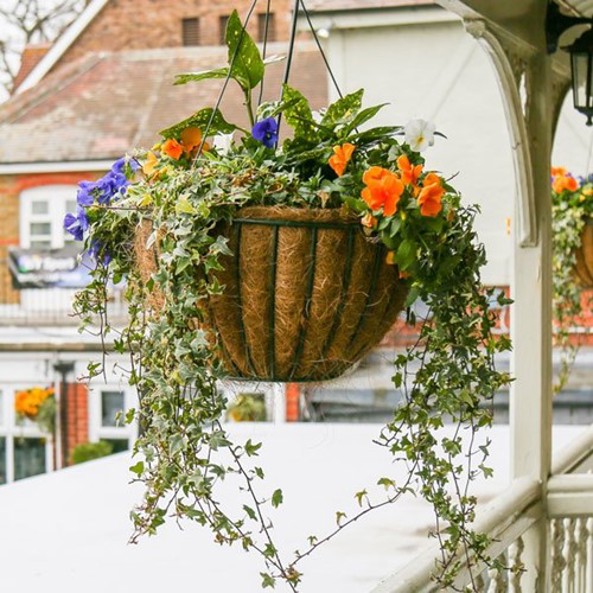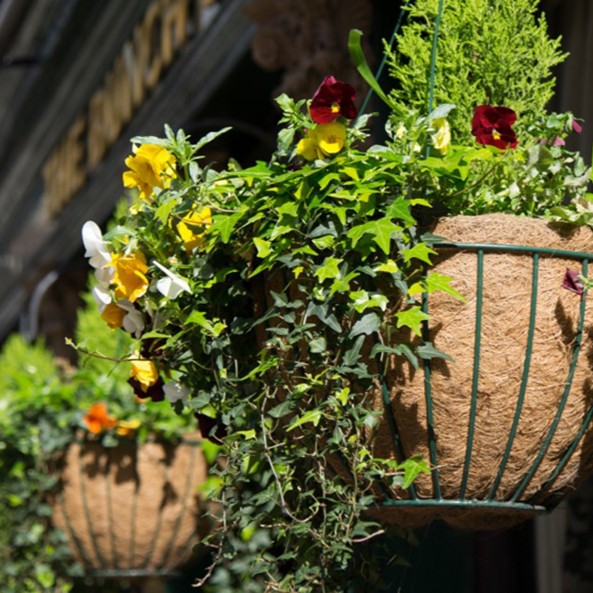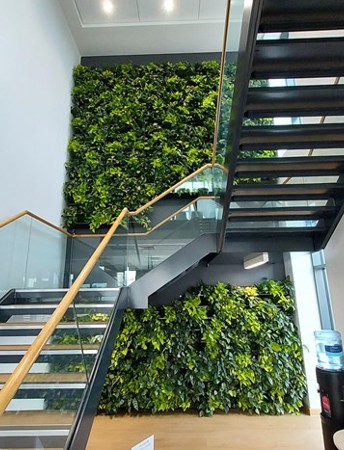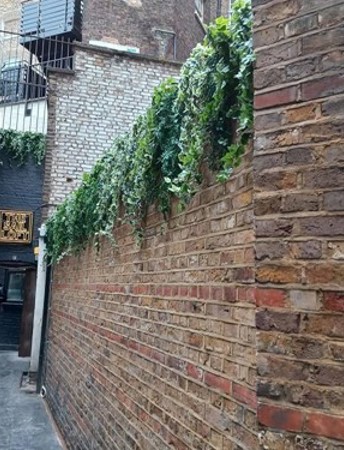Hanging baskets are a delightful way to cheer up the outside of any building.
They add a touch of brightness to any home, while shops, offices, restaurants and leisure facilities all feel more welcoming with a few of the nation’s favourite suspended floral decorations.
But it isn’t just a case of sticking a few plants in a basket and hoping for the best. You need to find the right combination of plants, basket, liner and compost, as well as be prepared to invest a little time and effort in looking after them. There are a lot of hanging basket ideas to consider, and you’ll find plenty of hanging basket inspiration to help you find a suitable style. With a little TLC, you can make sure that a ‘quick fix’ turns into a season full of interest and colour.
Get some expert tips on how to create hanging baskets that last from phs Greenleaf.
Top Questions About Hanging Baskets
At phs Greenleaf, we’ve got over 25 years of planting and landscaping experience in producing and maintaining more than 35,000 hanging baskets each year as part of award-winning displays throughout the UK. You could say that we know a thing or two about how to put together the right hanging baskets for striking impact and keep them looking their best.
If you’re keen to turn the outside of your home or premises into something that’s blooming marvellous, we’re here to offer a helping hand. Here are some of the most frequently asked questions when it comes to finding the right way to create hanging baskets that last:
- Why should I use hanging baskets?
- When should I plant hanging baskets?
- What are the best plants for hanging baskets?
- What’s the best number of plants to put in a hanging basket?
- What type of liner should I use in my hanging baskets?
- Which is the right compost for my hanging baskets?
- How and where should I install my hanging baskets?
- How often should I water my hanging baskets?
- How long should hanging baskets last?
- How can I keep hanging baskets from drying out?
- How can I keep my hanging baskets healthy?
- How do I know when my hanging baskets are past their best?
- What’s the alternative to planting and maintaining my own hanging baskets?

Stick to our advice and you’ll soon be enjoying relatively fuss-free, healthy and eye-catching hanging baskets to delight staff and customers, family and friends alike.
The benefits of hanging baskets are many, and with inventive planting and interesting basket shapes, their popularity has increased in recent years. With a bit of creativity, you can achieve every look from country cottage to funky florals!
People don’t often look down, so eye-level colour will always attract attention more easily than plants or flowers in the ground. Hanging baskets don’t require landscaping or digging, are easy to replace and aren’t at risk from trampling by overenthusiastic customers or guests. They also avoid much of the damage that can be caused by pets or wildlife, making life easier all around. Hanging baskets easily contained and can be put together indoors or even at a different location before being placed in situ to add lasting colour.
They are especially useful if you have limited floor space or want to use any available room for another purpose, for example a seating area or product display. Hanging baskets can be displayed throughout the year – as long as you choose your plants wisely – and can even be used to grow fruits and vegetables, such as strawberries and tomatoes, lettuces and peas.
Used to grow aromatic or sweet-smelling plants, hanging baskets can provide not only a visual pleasure but also a fragrant treat next to your doorway – the perfect welcome to your establishment.
So, if you are looking for planting that will make an impact quickly and relatively inexpensively, hanging baskets could be the way to go.
As soon as we start to spend a little bit of time outdoors, our green fingers begin to twitch as our eyes start to seek out a bit of colour in our gardens, workplaces and leisure spaces. But wait! Timing is everything when you want to impress.
The answer to the question, ‘When should I plant hanging baskets?’ is, ‘When do you need them?’ For the wedding season at your hotel, a garden party at your home or the launch of your new restaurant, for example, you’ll have to think ahead. If you plant your hanging baskets a few weeks before you expect them to be at their best, they should be ready to delight and inspire when they need to be.
In the UK, it’s usually safe to plant for summer colour any time after April, when the frosts have passed, unless you have a greenhouse in which to store them and prevent damage during a cold snap when you can plant much earlier.
Once the sunshine (if we’re lucky) begins to fade in September and October, it’ll be time to plant up winter hanging baskets with tougher plants that will withstand any frosty spells.
Where perennials (plants that flower year after year) are concerned, you should be able to plant your hanging baskets in April and expect them to last through to flower again the following spring, with sufficient care and attention.
The time of planting very much depends on the occasion you wish to plant for and any particular flower or shrub you have in mind…
Whether you want to attract attention or provide a backdrop of greenery, the plants you use in your hanging basket will have to be fit for the job. Bedding plants can provide a short-term burst of colour while herbs, evergreens and shrubs can be relied upon for long-lasting interest. And don’t forget to bear in mind the time of year when determining your choice of plants – some plants thrive in heat and sunshine, others not so much.
Summer favourites, such as Petunia, Fuchsia, Geranium, Lobelia, Viola, Begonia and creeping Jenny (Lysimachia) are excellent choices for lasting though the warmer months, if carefully tended.
Cooler months require hardier plants, such as Crocus, Primula, Cyclamen and flowering heathers.
Plants that will trail out and down from the basket lend themselves particularly well to a hanging display. Try Verbena, Rave Violet, Nasturtium or Surfinia.
Add interest to your basket with a central plant such as a Box shrub, Cordyline or Salvia which should last throughout the year. Complement the architectural foliage with seasonal flowering plants and simply swap out the summer stock for those more suited to winter as the seasons change.
Bear in mind your colour scheme, if you have one, when choosing your plants. Most varieties come in an array of colours – reds, pinks, purples, yellows and blues. You can use the same variety of flower throughout or change it up a bit with a mixture of different shapes and shades.
And last but by no means least, consider where you’ll be installing your hanging masterpiece – shade, partial or full sun; north, south, east or west-facing – as this will have a bearing on which plants will flourish and which won’t.
Unless you’re thinking way in advance, plug plants (rather than bulbs or seeds) will give faster results in your hanging basket. The number of plants you use will greatly depend on the size of the basket and the available space – too few and they’ll look lost in their new home (although they’ll probably spread given enough time), too many and you run the risk of your basket collapsing from the weight as the arrangement grows to gargantuan proportions.
Because the aim of the game is to have your display literally bursting out of the basket, you’ll need to plant more closely than you would in a garden border – slightly less than one plant per inch of basket. We’d recommend using a basket no smaller than 12” in diameter in order to comfortably accommodate all of the plant roots and required water. So, for a typical 12” basket, aim for around 8-10 plants.
You’ll need fewer plants for faster growing varieties – simply ask your supplier to advise on the growth rates.
If you start with a central plant, you can then plan the rest of your display around this. Don’t forget that each plant will grow and spread, so initially your hanging basket may look a bit sparse. This is why it’s good to plan ahead and plant up a few weeks before moving your display to their permanent position so that they are well on their way to spreading nicely when they are installed.
As mentioned above, the central plant can be a constant focus throughout the seasons, taking attention away from smaller plants that may not be thriving, and allowing you to easily swap out those that are struggling. Make sure that you include trailing plants around the edge of the basket to achieve the full effect.
Many hanging basket kits come complete with a basket and cardboard liner that prevents the compost, plants and water from ending up on the floor! Some liners work better than others at retaining moisture while also allowing for the right amount of drainage and the prevention of overwatering. You’ll also want the liner to look good wherever there are gaps in the foliage.
Moss is a perfect and natural option, and when used in conjunction with perforated polythene, provides adequate water retention. A coir (or coco) liner is another preferred choice which you might find easier to work with than moss, and also boasts excellent water retaining properties.
Burlap/hessian is another popular organic alternative, although it holds very little water. Simply line the basket with around half an inch of your chosen material (then the perforated polythene, if required) before beginning to fill with compost.
Depending on how long you want your hanging basket display to last, you’ll have to think about using the right compost. A multi-purpose compost will do the job, just fine but there are much better alternatives.
Choose a compost that has been specially formulated for containers and you’ll probably find your maintenance is a lot easier. Fertilisers, slow release feed and water-retaining pellets are things to look out for to help your flowers to thrive with minimum effort on your part.
When you pick a compost, you’ll also have to consider the type of plants you’re using. Ericaceous plants, such as Azalea or heathers will require a special acidic soil in order to reach their potential.
Half fill your lined basket with your chosen compost, arrange your plants and then carefully, but firmly, fill around the root balls with more compost. Completely fill to around an inch below the top of the basket to allow room for water, then give your hanging basket a long and well-earned drink of water.
Remember that when your hanging baskets are in full bloom and full of water, they will be very heavy. You need to ensure that the wall or pillar on which you are intending to install them is strong enough. The fixtures and fitting that you use must also be of good quality and able to bear the required weight.
If installing your display on a wall, use a masonry bit and make sure to drill into the bricks themselves and not into the cement between them which will provide little grip. Wherever possible, avoid fixing the baskets directly above a seating or walking area, unless you have had the baskets professionally attached.
Choosing the position should be fairly straightforward. Plan for maximum impact at an entrance or alongside a walkway, next to a shop sign or at your favourite spot in the garden. Try to steer clear of any areas that are regularly exposed to harsh winds when even the hardiest of flowers won’t stand a chance. Also avoid spots that are in full sunshine for all or most of the day as this will just act to dry out the plants and compost prematurely.
Planting and installing your hanging baskets is just the beginning. Now it’s time to begin on the maintenance program so that your work thus far can be appreciated for a good while.
As with most living things, water is key to the survival of your hanging baskets. Unlike plants in the ground, hanging baskets have a limited supply of water and so are heavily reliant on a helping hand to keep them moist. You should water the plants as and when the soil dries out to ensure that your display has all it needs to continue to thrive. This could mean a bit of trial and error to being with until you can figure out the rate at which the plants take up water. Test the soil at several different times in the day, if it feels dry, water your hanging baskets.
Obviously if it rains a decent amount, you’ll be able to stand down from watering duties for a while (assuming that your hanging baskets aren’t sheltered) but you should continue to check the soil regularly.
The amount of water you provide also varies from basket to basket. Over watering can be just as detrimental as drying out, so ensure that you stop filling as soon as water starts to overspill from the basket.
How long your hanging basket will last will depend on the types of hanging baskets you have. If you have one with annual plants, they will last for around a year. However, those with perennial plants can last as long as five years with the right care.
Hanging baskets are a great investment for a long-term flower arrangement. If they’re cared for properly, they won’t need regular replacing like flowers in a vase would. For businesses, hanging baskets can take you through multiple seasons, helping you keep your premises looking attractive and welcoming.
Check how often you should water hanging baskets and other care tips to help your arrangements last longer.
Aside from regular watering, there are other steps that you can take to avoid your hanging baskets drying out. As mentioned earlier, some container composts have added water-retaining granules which will stop a good amount of water from draining away.
Water at the right time of day by avoiding the sun at its highest, when it is most likely to dry the compost more quickly. And perhaps consider installing a watering system that you can program to do the job for you.
Plant choices can again play a role here, so choose wisely. Some varieties need more water than others and will greedily drink anything you throw at them, causing the rest of their companion plants to suffer. If you are going to struggle to provide enough water regularly, you should avoid these plants.
Winter baskets still need water, though the risk of waterlogging is greater in the colder months. Again, you should be sensible by checking the soil before you water.
When it comes to plant maintenance, watering isn’t the only important task. There’s a whole routine that must be followed to ensure that your hanging baskets look fabulous, and stay that way:
Remove unsightly parts of the display by regularly deadheading faded flowers. This will divert the plant’s energy into producing more flowers, rather than producing seeds, which would be the normal course of the plant cycle. It will also prevent debris from dropping from the baskets. Most blooms will break away easily when pinched between finger and thumb, just below the head.
Feed once a week with a liquid fertiliser, even if you’ve used an enriched compost during planting, as added fertilisers are soon used up, especially in early growth stages.
Look out for signs of weathering and consider moving the hanging basket to a more sheltered position if it looks like it has been affected by wind or sun. Winter baskets should be closely monitored, especially as the cold spell hits when you should think about moving them indoors or covering with a fleece layer if frost looks likely to set in.
Keep your eyes open for creepy crawlies like slugs, snails, aphids, and vine weevil, and diseases such as mildews, rusts. Isolate any offenders and treat accordingly.
It’ll be fairly easy to tell when your hanging baskets have had their day, especially if you are sticking to a regular maintenance routine. Obvious signs are bald spot sin the display, drooping or discoloured leaves, fading colours and dried up foliage. This can happen because the plants have had too much or too little water; too much sunlight, or not enough; or have simply come to the end of their cycle.
When you spot these signs, try adjusting your watering routine or moving to a brighter or shadier spot to see if the display can be revived. Failing this, it may be time to completely replant your hanging basket or swap out the unhealthy plants for younger, fresher ones.
If the roots or stems of the stricken plants are still alive, you may be able to save them by trimming back, placing them somewhere in half light and only watering when the soil is dry.
Creating and looking after a collection of hanging baskets isn’t as easy as you may think, especially if you’re doing it on a large scale, to enhance your commercial premises, for example. Why not let the experts take control? phs Greenleaf can supply, install and maintain your hanging baskets all year around and combine them with a range of complementary planters and outdoor displays.
Our nurseries select and grow suitable flowering varieties that flourish in hanging baskets, whatever your request for time of year, aspect or colour. And our expert horticulturalists know exactly which combination of baskets, liners, compost and number of plants to use, so you don’t have to worry about whether you’ve chosen the right plants in suitable quantities.
We’ll survey your premises, fit the baskets to walls or pillars, and even install automatic watering systems and carry out regular maintenance so that you, your staff and customers can all enjoy the fruits of our labour, month after month – flower power at its best!
Beautiful, Professional Hanging Baskets From phs Greenleaf
Hanging baskets are a simple way to dress up your business, adding a welcoming and attractive touch. But as you can see from above, it takes a lot of work to create hanging baskets that last. At phs Greenleaf, we provide a complete solution to take care of all of your hanging basket needs. From summer hanging baskets to winter hanging baskets, we can kit out your business year-round.


With the help of our managed service, we’ll care and maintain them for you too. You won’t need to worry about how often you should water hanging baskets or the best compost for hanging baskets – leave that to us. Contact phs Greenleaf today to find out more about our landscaping and floral design services and enjoy the benefits of hanging baskets for your business.




































